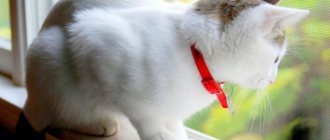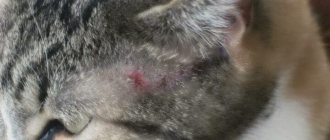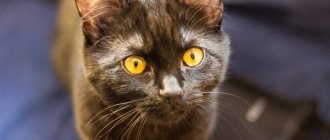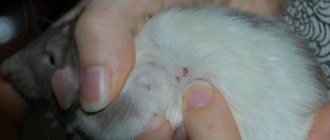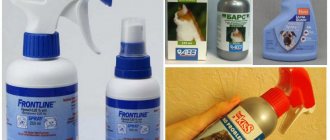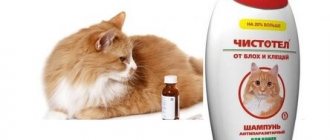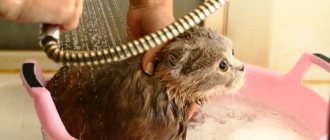The infestation of cats by fleas in cities and towns in Russia is usually seasonal and by the end of summer and autumn, up to 70% of cats are affected by this ectoparasite.
In nature, there are more than 100 species of fleas that infect our domestic animals, and some of them can attack humans.
Ctenocephalides felis (cat flea) is mainly found in cats. Simultaneously with cat fleas, cats can be attacked by fleas from dogs and rodents.
Morphology and development cycle.
Fleas are wingless insects. They have a bilaterally flattened body, covered with numerous spines and bristles, thanks to which fleas are held between the hairs of the cat's fur. The flea has six legs, the two back ones are more developed, thanks to which the flea has the ability to move in the cat’s hair at any angle and make long jumps, up to 1.5 meters. On the flea's abdomen there are special tactile hairs that are very sensitive to any air fluctuations. The chitinous cover protects the flea from any mechanical damage. Adults are brown in color, the size of the female is 2-2.3 mm, the size of the male is 2-2.5 mm. The mouthparts are piercing-sucking, simple eyes, epipharynx and antennae are located on the chitinous head. Adult fleas feed on the cat's blood. Sometimes they can feed on the blood of other animals. Blood enters the flea's stomach. Which has a volume of about 0.5µl, while at the same time, when sucking cat blood, the stomach can accommodate a blood volume 10-20 times larger. The flea's stomach is able to digest a small amount of blood consumed; most of the blood is released by the flea into the cat's hair in the form of small black feces. It has been noted that the flea has the ability to starve for several months. Upon external examination of flea-infested fur, we find a large amount of these feces, which look like poppy seeds.
The flea is an insect with a full development cycle. It has the stages of adult insect, egg, imago and pupa. The female flea lays her eggs wherever necessary, due to the absence of a sticky mass on its surface, from which after about 2 weeks a worm-like larva appears, which begins to grow, molting several times. Indoors, the larvae live in dust and debris, feeding on decaying organic matter and excrement. Later, the larva pupates and after some time an adult insect emerges from the pupa. The insect's lifespan is approximately 2 years. Parasites reproduce very actively; during her life, a female flea can lay up to 2 thousand eggs.
Pathogenesis. When fleas come into contact with a cat, they bite through the epidermis and begin to suck blood from the bitten capillaries. As a result of a massive flea infestation, a cat may develop multiple bites on its skin within a few minutes. The cat develops an allergic reaction to antigens that are present in the flea’s saliva and are introduced into the cat’s skin through bites, and allergic dermatitis appears. As a result of a flea bite with its infected blood, feline infectious anemia (hemobartonellosis), in which red blood cells are damaged, can be transmitted to a cat through a damaged membrane. It has been established that fleas contribute to the infection of cats with invasive diseases. In particularly sensitive cats, prolonged itching can develop even with a small number of fleas parasitizing the cat. As a result of constant itching, papules, scabs and bald patches appear on the cat's skin.
Clinical picture. A cat affected by fleas is accompanied by the presence of severely itchy areas on the body, and the cat not only constantly itches, but bites into the bite site with its teeth. As a result of constant scratching, the hair falls out in certain areas of the body (the neck area is most often affected), and the combed skin becomes covered with reddish crusts. Constant itching makes the cat nervous. During a clinical examination, the veterinarian finds flat miniature dots attached to the skin in the hair, similar in appearance to millet grains. Having drunk blood, fleas begin to move actively, and in some cases, jump. Using a magnifying glass, you can notice a dark brown, flat, elongated body measuring 2 or 3 mm, no wings, and long, jumping hind legs. In the depths of the fur near the skin, upon careful examination, a specialist finds waste products of fleas - dark-colored, fine-grained excrement. At the same time, upon careful examination, you can find flea eggs, which, unlike excrement, are oval in shape, larger and white in color.
In cats, as a result of flea infestation, complications often occur in the form of pyotraumatic dermatitis. With severe flea infestation, anemia is recorded as a result of a decrease in the amount of blood. Sometimes we note symptoms of lymphadenopathy and eosinophilia.
Unlike lice and lice eaters (which are parasitic bloodsuckers), fleas have great jumping ability when viewed, jumping up to a height of half a meter, and can move along the cat’s body, covering as much as 30 cm in one jump. While the louse crawls over its victim.
The diagnosis of a cat being affected by fleas is made based on the collected history, clinical picture of the disease, season and, of course, on the basis of the detection of fleas or flea feces. When making a diagnosis, you can resort to thorough combing of the fur with a thick comb. Place the particles combed out of the hair onto moistened filter paper. After a few minutes, a red zone appears around the combed out grains - representing flea feces with excess blood. The presence of a red zone is considered to be a diagnostic sign of a cat being affected by fleas, even if no living fleas are found. The disease is accompanied by the presence of eosinophilia in the cat.
Differential diagnosis. When conducting a differential diagnosis, veterinary specialists must exclude the presence of other ectoparasites (ticks, lice), dermatophytoses (ringworm, etc.), folliculitis, dietary disorders (lack of biotin, essential fatty acids), and food allergies in the cat.
Features of the insect
What are fleas? These are blood-sucking parasites. They are quite unpretentious and tenacious. Squashing a flea is not easy because of its body structure. The parasite has legs designed for jumping long distances. Fleas can go without food and survive for weeks this way. These insects are very prolific, which also poses a serious problem.
What do fleas look like and why are they dangerous?
Fleas have a mouthpart that allows them to bite through the skin of an animal and feed on its blood. Thanks to their laterally flattened body and small, rounded head, insects can move quickly through cat fur. On the surface of the flea's body there are bristly ridges, which also help the parasite cover distances on the animal's body. The flea has six legs, the back two of which are especially well developed. This allows fleas to jump up to half a meter.
These parasites pose a serious danger primarily to kittens, as well as weakened, sick and old animals. Fleas can cause anemia in kittens because one parasite drinks large amounts of blood. In the most advanced cases, fleas can lead to the death of the animal.
In addition to the fact that fleas feed on the blood of animals, they are also carriers of many dangerous diseases. For some types of helminths, fleas are an intermediate host. An animal can accidentally swallow a flea and then the helminth eggs enter the body directly, where they become larvae and then turn into adult parasites.
At the same time, the cat’s skin and fur also suffer greatly. The coat may fall out, lose shine and look unkempt.
Types of fleas in cats
The most common flea that affects cats is C felis, also known as the cat flea. The size of parasites of this species is small - from 2 to 4 mm. They do not have wings, and their small head and laterally flattened body allow them to easily move among the cat’s fur, clinging to the hairs with bristles and spines.
Where do fleas come from?
Fleas are parasites that are active all year round. They live not only on the street, but also in the basements of residential buildings and entrances. You may not even notice the larval eggs hidden in the corners of your apartment: behind baseboards, in cracks, in furniture and folds of linen. The larvae feed on dust and other contaminants, and then, upon reaching sexual maturity, migrate to a pet. Therefore, even a domestic cat can become infected with parasites that you accidentally brought from the street on your clothes or shoes.
Symptoms of flea infestation
You won't be able to avoid noticing fleas on your cat for a long time. The animal quickly begins to show the following signs of the disease:
- An infected cat begins to actively scratch and bite itself, trying to catch parasites.
- The animal is nervous and meows.
- Black crumbs on the skin are parasite excrement and dried blood from scratching bites.
- When examining the cat's back or scruff, you may notice bite marks.
- The presence of fleas themselves on the animal’s fur.
Are fleas the same on dogs and cats?
It happens that dogs and cats suffer from the same type of fleas. Dogs and cats can be parasitized by a specific type of parasite - the cat flea. At the same time, there is also a dog flea, which parasitizes exclusively on dogs.
How often can fleas be poisoned?
The procedure for killing fleas using special drops is carried out once. If necessary, the procedure is repeated after two months. At the same time, the room is treated with special means: the floor, baseboards and the animal’s sleeping area.
Flea development cycle
To know how to fight fleas, it is important to understand how and under what conditions this parasite reproduces.
Fleas are wingless blood-sucking insects that, contrary to popular belief, do not live on cats and dogs, but only feed. They live in dark, warm, damp places: in the warm season they feel comfortable in grass and rotting plant debris, and all year round they can live in basements, attics and apartments. The optimal conditions for the parasite are a temperature of 20 to 30 degrees and a relative air humidity of no more than 70% - completely room conditions.
Female fleas lay eggs in the shelter. The larvae can hatch from them in 2 days, or in 2 weeks, it depends on the conditions. The larvae then form pupae, a developmental stage that is most resistant to both environmental conditions and insect repellents. This is extremely important in cases where a colony of fleas has settled in the apartment.
A flea can grow from an egg to an adult sexually mature insect in 3 weeks, or maybe in 2 years. An adult flea also lives for about 2 years, and can survive without food (animal or human blood) for months.
Are fleas dangerous for humans?
Fleas can cause discomfort not only to pets, but also to humans. At times, parasites bother people by biting them, and any fears about this are not unfounded. After the bites of these parasites, unpleasant consequences can be observed on the skin in the form of blisters and papules. In addition, fleas can cause a skin infection in humans, which manifests itself in the form of ulcers or abscesses.
A person can become infected with helminthiasis by accidentally getting cat fleas into their mouth. The disease is asymptomatic in most cases.
Are cat fleas transmitted to humans? This depends on the gender and age of the pet. For example, a kitten's fleas are more likely to be transmitted to humans and begin to bite both the animal and its owner. Fleas are transmitted from cats to humans more often than from cats.
People
While the common cat flea prefers furry hosts, they happily bite people and hide in our clothes and shoes. Once their preferred prey is nearby, fleas will easily jump over 100 times their own length to get from person to pet.
Okay, so it's not practical to test every person who enters your home for fleas and ticks, but there are things you can do to reduce the likelihood of a flea infestation. Regular house cleaning, vacuuming floors, carpets and upholstery can help kill flea eggs and flea larvae and get rid of any human-borne invaders. Wash guest sheets and towels after you leave, and regularly put your pet's bedding and blankets through a hot wash cycle.
Also check your pets by grooming your cat with a flea comb and gently parting the fur to look for tell-tale signs of bites, flea dirt, or fleas themselves.
Traditional methods for getting rid of fleas on cats
Our ancestors often used various natural methods to get rid of fleas from cats. These were simple and effective methods. Unlike modern remedies, traditional methods are less harmful and act by repelling parasites.
Sagebrush
This herb is often used in the fight against fleas, because wormwood repels them with its specific smell. To get rid of parasites in the house, spread dry wormwood around the apartment, and also rinse the cat's fur after bathing with a decoction of wormwood.
Garlic
The garlic smell also forces fleas to leave the animal alone. To prepare garlic tincture, take 6-7 large cloves of garlic. Then grind them with a squeezer and pour 3-4 glasses of water at room temperature. The infusion is prepared within 12 hours. Wipe the cat's fur with the prepared infusion, but do not allow the garlic to get inside, otherwise it may cause poisoning.
Vinegar
Using vinegar is a rather drastic measure, but this method helps to quickly get rid of fleas. Mix vinegar, ammonia and any floral cologne in equal proportions. Pour the resulting mixture into a spray bottle and spray the cat's fur. Then place the animal in a plastic bag without covering the animal's head so that the cat can breathe. Hold your pet for 7-10 minutes, then wash and comb the pet's fur thoroughly to remove any dead parasites.
Pine sawdust
Fleas hate the smell of pine. To prevent fleas, you can fill the animal's bed with small pine sawdust or place small bags of sawdust throughout the apartment.
Salt
Take 1 kg of table salt and dilute it with a little water. The salt should completely dissolve. Dilute the resulting mixture with 10 liters of warm water. Wash your cat in it for 5-7 minutes. All wool should be saturated with saline solution. Then bathe your cat in warm water.
Salt and soda
This method is suitable for killing parasite larvae on the carpet. Mix soda and salt in equal proportions and leave the resulting powder for ten hours. Then sprinkle the product on the carpet and spread it with a brush. After 4-6 hours, remove the powder from the carpet using a vacuum cleaner. Salt, getting on the body of the parasite, destroys it. As a result, not only the larvae will die, but also the adults.
Decoction of lavender and geranium
Pour 30 grams of lavender and geranium into 3 full glasses of clean water. The mixture is boiled, stirring, for 15–20 minutes. The resulting solution is cooled and filtered. The cat is bathed in this solution, as in regular shampoo. Be careful and avoid contact with the animal's mucous membranes.
Citruses and essential oils
Slice one lemon and pour 2 cups of warm water over it. Let it brew for a day in a dark place. Apply the finished product to your pet's fur using a spray bottle.
To treat wool, 2-3 drops of lavender, rosemary, geranium, mint or lemon oil per 3 glasses of water will be enough. Oils can be dripped onto the collar.
Anti-flea shampoo recipe
Take one third of baby soap, grate and mix with 3 glasses of water. Let the mixture simmer over low heat until it turns into a jelly. Let it cool, and then add one finely chopped onion, one egg yolk and a spoonful of nettle infusion. Lather your cat with this shampoo, leave it for 15–20 minutes and rinse well.
Tar soap
Beat the tar soap into a strong foam. Apply foam to your pet's fur and rinse off after 5 minutes. The procedure is carried out every 3-4 days until the parasites disappear completely.
Hydrogen peroxide
Place the cat in a basin and apply hydrogen peroxide diluted with water to its body. Be careful not to get hydrogen peroxide in your pet's eyes, mouth, or nose.
Safe pest control products
One of the important components of cat treatment is how safe the chosen method is for the pet’s health. To avoid harming your cat, you can opt for natural and safe products.
Combing out fleas
Short-haired cats can be combed with a fine-tooth comb. Brush the coat with a fine-tooth comb and then with a fine-tooth comb. Shake parasites from combs into a bowl of soapy water. In this way, you can remove some fleas from the skin of animals, but this will not completely solve the problem.
Herbal treatment and eco-collar against fleas
Some herbs, such as chamomile, rosemary, wormwood and wormwood, geranium and tansy, are considered natural remedies for fighting parasites. There are three ways to herbally treat an animal:
- Herbal rub. Soak a cotton swab in the herbal infusion and wipe the cat's fur.
- Herbal shower. Rinse your cat's fur with the herbal infusion and let it dry.
- Herbal powder. Sprinkle the powder on the areas where insects are most concentrated on the animal’s body.
To make your own eco-collar that is safe for your cat, you will need absorbent fabric. Sew a strip from it around the circumference of the animal’s neck, adding 2 cm to the length. Sew Velcro on both sides of the collar and treat the fabric with a special compound:
- 1 drop of lavender oil;
- 1 drop of thyme oil;
- 1 drop of eucalyptus oil;
- 1 drop of citronella oil;
- 5 ml alcohol;
- 10 ml jojoba oil.
Do not wring out the collar and place it on the animal's neck. After 30 days, replace the eco-collar.
Washing the bed, toys and cleaning the house
These harmful insects live not only on the animal, but also where the cat spends the most time. To kill any parasites living in your cat's bed, wash it in soapy, hot water at least once a week.
Aromatization of the room
If you have an aroma lamp, then you can scent the room. Use essential oils of lavender, thyme, rosemary, tea tree or eucalyptus.
You can also finely chop the garlic and place it on plates around the apartment. This smell will repel fleas.
If you like to grow flowers, then plant geraniums or lavender in pots.
Boosting immunity and love
Make your pet's diet balanced and add vitamins to it. The best option would be to switch to high quality food. Add brewer's yeast to your cat's diet - fleas cannot tolerate it.
Don't forget to show love and care. Give your pet attention and play with her. As a rule, happy animals do not get sick as often.
Intradermal allergy test for flea saliva
The third type of research should be carried out in laboratory conditions. Before prescribing an intradermal allergy test for flea saliva, the veterinarian will conduct a general clinical examination of the cat and collect an anamnesis. A specific study may be necessary if the cat has developed flea dermatitis, which is an allergic reaction to the saliva of blood-sucking insects, but there are no fleas themselves.
In a clinical setting, the doctor gives the cat an allegotest. To do this, allergens are administered subcutaneously to determine the body's sensitivity to certain substances. Based on the data obtained, the specialist develops treatment tactics.
Flea remedies for cats
If your cat is already suffering from fleas, it is best to consult your veterinarian. He will help you choose the appropriate treatment. The form of the product does not matter, but its effectiveness does. A good product should have a pronounced effect and be safe for the cat.
Drops on the withers
Drops are an effective remedy for parasites. They are applied to the animal’s withers near the neck and between the shoulder blades so that the cat cannot reach there. The drops kill adult parasites and also repel them and prevent them from remaining on the cat's fur. There is a large selection of drops on the market and you can easily find a suitable product, but under no circumstances use drops containing permethrin - this substance is dangerous and can cause poisoning in a cat or be fatal.
Shampoos
Shampoos are used when the animal is already infected with parasites. Lather your cat well with shampoo, avoiding contact with the eyes and ears. Leave the shampoo on the cat's fur for about 10 minutes and then rinse thoroughly, because the cat may get a dose of the drug during the licking process.
Collars
Depending on the manufacturer of the collar, its validity period is limited to 4 to 7 months. Collars made from amitraz, organophosphates and permethrin are very dangerous for cats, so they should not be purchased.
Powders, powders
As a rule, natural and safe ingredients are used in powder products. Powders and powders are suitable for both kittens from 3 months of age and pregnant cats. Using such products is quite simple: apply the powder to the animal’s body and thoroughly rub it into the skin. However, this option is not suitable for cats with long and thick hair.
Chewable tablets
Once in the animal’s body, the tablet is absorbed into the intestinal wall and dissolves in the blood. Thanks to the insecticidal composition of the drug, it will be enough for the parasite to drink the blood of the animal that took the pill in order to die.
Injections
Injections and pricks are not used as often in the fight against fleas in cats. Together with the injection solution, substances that help kill insects enter the animal’s body. But do not forget that injections can be hepatotoxic, so it is better to give preference to other means.
Vaccinations
Flea vaccinations are an effective method. By biting the vaccinated animal, the parasites receive a dose of poison, which causes paralysis and leads to death. To vaccinate your pet, you need to see a veterinarian, who will give him an injection. This procedure protects the animal for exactly one month.
Sprays
Flea sprays are available in the form of aerosols and cans. The product is quite effective, but not all animals will like it, because many animals are simply afraid of the sound of spraying. When treating cat fur, the spray should not get into the eyes, ears or mucous membranes. The cat's head is also treated: using a cotton swab soaked in spray.
The cat runs out into the street
Sooner or later, your indoor cat will turn into an outdoor cat, at least temporarily, such as when you need to take it to the vet, groomer, or even to a cat shelter or pet shelter.
Here they may come into contact with other animals and potentially pick up fleas. The best protection is regular flea treatment, so keep a calendar reminder to get regular doses.
Cropped image of beautiful female doctor veterinarian with stethoscope is examining cute gray cat at vet clinic.
Rating of the best remedies for fleas for cats and cats
There are a sufficient number of different drugs available on the anti-flea market. You can choose the right remedy based on the cat’s age, pregnancy, or the urgency of getting rid of parasites.
Flea shampoos
These flea treatments have a short-term effect. After bathing your cat, you need to rinse off the shampoo thoroughly so that by licking it off, your pet does not receive a dose of a toxic substance.
Spray Frontline
The product protects cats from fleas, and is also approved for use on kittens from the second day of life and on pregnant or lactating cats.
Drops on the withers "Bars"
The least toxic flea treatment for cats, which is highly effective. Suitable for cats from 8 weeks of age as a treatment and prevention for fleas.
Spray Hartz
The product can be used to treat kittens for fleas no earlier than 12 weeks of age. After a single treatment, harmful insects die within 5–10 minutes.
Drops on the withers "Lawyer"
The drops are suitable for cats from 9 weeks of age, as well as pregnant and lactating animals. The product has a protective and healing effect for 4 weeks.
Drops on the withers "Advantage"
The product helps rid your cat of fleas on the first day of treatment. The therapeutic effect of Advantage drops lasts for 4 weeks. Reduces the number of flea bites within 3-5 minutes after the parasites come into contact with the drug.
Bolfo aerosol against fleas for cats
The aerosol can be used to treat not only a sick animal, but also its bedding or other care items. Repeated treatment is carried out no more than once a week. The product is suitable for kittens from 3 months of age. Use for the treatment of pregnant and lactating animals is possible only after consultation with a veterinarian.
Drops on the withers for cats Stronghold
The drug has the following advantages: it dries quickly, is moisture resistant, has no unpleasant odor and stops the incubation of flea eggs. The drops can be safely used on kittens from 6 weeks of age.
How to remove fleas at home
The history of cohabitation between humans and representatives of the cat family goes back more than one millennium. During this time, scientists have invented and improved many methods to get rid of fleas from cats. Today, the most effective is the use of insecticides.
Important
: insecticidal preparations with a high concentration of the active substance should not be used to treat pregnant and lactating females, kittens under three months of age, elderly and sick animals. Insecticides should be used with extreme caution for pets with a history of allergic reactions (regardless of the type of allergen).
Specialists at the Jungle veterinary clinic advise not to treat your pet yourself, especially if your furry friend suffers from chronic diseases such as oncology. Only a qualified veterinarian can adequately assess the state of his health and, depending on the specific situation, prescribe the optimal therapy for removing fleas from a cat with effective drugs. If necessary, the doctor will also prescribe vitamins and immunomodulators to strengthen the immune system, because a weakened body suffers from the consequences of bites much more than a healthy one.
Basic rules for removing parasites
:
- the dosage of medications used depends on the weight and age of the pet;
- It is imperative to adhere to the recommendations specified in the annotation for the drug, and also pay attention to the expiration date of its action. Otherwise, you can cause irreparable harm to your four-legged pet.
Before using any flea insecticide for the first time, you need to check your pet's reaction to it. Intolerance may occur. And this can result in suffocation and even death. Therefore, a few hours before the sanitary procedure, spray the spray on a small area of hair or drop a drop of liquid product. If within a couple of hours the cat does not start sneezing, tears, nasal discharge, or skin rashes appear, then everything is in order and treatment can be carried out.
Removing fleas from kittens depending on age
The appearance of a kitten in the house is a joyful event. But it can be overshadowed by the appearance of uninvited guests in the house in the form of fleas. You should carefully choose flea products for kittens, since not all products are suitable for them and are selected depending on the age of the animal. You can remove fleas from a kitten in the following ways:
- Comb out parasites with a comb.
- Wash your kitten with flea shampoo.
- Use special drops on the withers, spray or flea collar.
Newborn kitten
Most flea medications are harmful to newborn kittens, so removing fleas at this age is a challenge. You cannot bathe kittens with flea shampoo at this age, so use a soft, thick comb to comb out parasites from the kitten. When combing out fleas, you need to apply pressure between your nails or with a hard object. A mother cat can independently rid her kitten of parasites using her teeth.
In kittens up to 1 month
If the number of fleas threatens the health or life of the baby, then you will have to bathe the kitten. You should not use special flea products; you will have to make do with baby or tar soap. Bathing water should be warm - 38–39oC. Bathing proceeds as follows:
- Pour water into a basin.
- Plug the kitten's ears with cotton wool.
- Wet the kitten with water and soap it. There is no need to wash the muzzle; it should remain dry.
- Lather your kitten for three minutes and then rinse off the lather thoroughly.
- Dry the animal with a soft cloth and comb out the fur.
Kitten of the second month of life
Most existing flea treatments are suitable for two-month-old kittens. You can bathe your kitten with anti-parasitic kitten shampoo and use some type of drops on the withers. But if the kitten is still feeding on mother’s milk, drops cannot be used on the withers. The cat may lick the drug from its fur, and some of it will pass into the milk, resulting in a negative effect on the kitten.
Kitten in the third month of life
As soon as the kitten has been weaned from its mother, in the third month of life it is already possible to use drops on the withers, sprays or flea collars.
Kittens from six months and older
To treat kittens from six months old, you can use all the remedies suitable for an adult cat:
- Flea collars.
- Flea sprays.
- Drops on the withers.
- Flea shampoos.
- Chewable anti-parasite tablets.
- Combing out parasites.
Wet paper test
After examining the pet's fur and skin, the owner may doubt the results without noticing a single insect. But if the cat continues to itch, you can do a test with a white sheet of paper.
First, a sheet of paper over which the animal will comb its comb can be moistened with a spray bottle.
When you brush a cat that has been bitten by fleas, small black-brown crumbs will begin to fall onto the white paper. This is flea feces. The fact that when it comes into contact with wet paper, excrement leaves a reddish tint helps confirm the guess. This is nothing more than the remains of the blood that the insect fed on.
This test should be carried out if no fleas were found during examination of the adult individuals themselves.
Eliminating the consequences of infection
To eliminate the consequences of flea infestation in the form of bites, you can use folk remedies. First you need to disinfect the bite sites with iodine, alcohol or antibacterial soap. Then you can apply a piece of ice or gauze soaked in cold water to the bite site. A longer lasting result is achieved by using Fenistil gel or Psilobalm. In addition to them, you can use tea tree oil, strong tea leaves or chamomile decoction. Soak a cotton pad in the liquid and apply to the bite areas.
Preventive recommendations
To prevent parasites from lingering in your home, it is recommended to clean with a vacuum cleaner as often as possible. The vacuum cleaner bag must be shaken out immediately after cleaning. Thoroughly clean the space under furniture, corners, and cat litter. Clean all areas where the animal is, such as a car or carrier.
Keep your home clean so that pests do not have food in the form of various debris and dust. As a preventative measure, repellents containing pyrethrins can also be used. They help protect the area from fleas.
There are a huge number of ways to deal with fleas in cats. You can use both natural folk remedies and modern medications, collars and shampoos in the fight against these parasites. The main thing is not to neglect the treatment of your pet and carry out preventive measures. As a result, all your efforts put into fighting fleas on your cat will be rewarded with happy purring and love from your pet.
Signs of the presence of parasites in an animal
Fleas on a cat cause him discomfort. The animal, with its restless behavior and constant scratching, will make it clear that it needs help. By spreading the hairs of the fur with your hands, you can see the presence of “guests”.
Other signs:
- the animal constantly bites itself and tries to catch the parasite;
- red dots are visible on the pet’s body;
- on the pet's resting place or on its rug, you can see parasite feces - they look like small dark dots.
